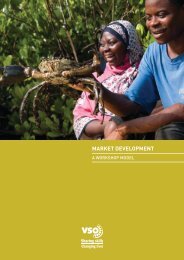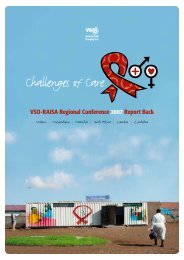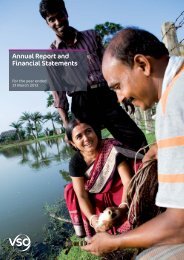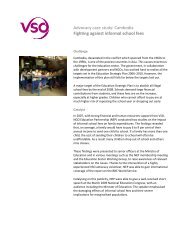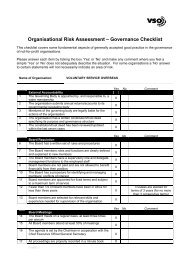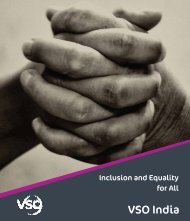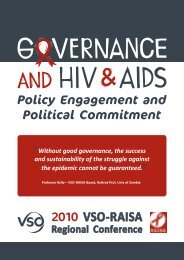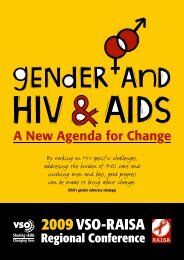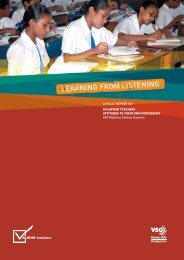Path of Partnership - VSO
Path of Partnership - VSO
Path of Partnership - VSO
Create successful ePaper yourself
Turn your PDF publications into a flip-book with our unique Google optimized e-Paper software.
organisations. This will help you ensure that you are working with the rightpartners to make the best impact for the beneficiaries specified in your PAP.Objective Task Details Guideline time1.1 Define your partnershipcriteriaCreate more specific 1 daycriteria that willguide theprogramme team asthey developpartnerships locally1.2 Undertake a comprehensivecontextual and stakeholderanalysis as part <strong>of</strong> the PAPdevelopment (newprogrammes)1.2 Participatory stakeholderanalysis (for programmesalready underway)1.3 Develop understanding <strong>of</strong>the organisations that maymake the greatest impactDesk-based and/or Several weeksfield-based researchto compile a list <strong>of</strong> allorganisationsworking in a sectoror geographical areaResearch and 2–8 hoursanalyse currentpartnerorganisations andnew or emergingorganisations in thesectorUse feedback from Several weeksbeneficiaries to gainan understanding <strong>of</strong>the potential forimpact <strong>of</strong> the variousorganisations that<strong>VSO</strong> could pursue apartnership withFor programme areas already in progress, the analysis <strong>of</strong> your partnershipportfolio will take place within the annual PAR process. Some preparationcould also be carried out in advance <strong>of</strong> the PAR to gather information aboutany emerging organisations in the sector.1.2 Who to involveThe <strong>VSO</strong> Programme Manager: has lead responsibility for getting toknow the context and pool <strong>of</strong> potential partners.<strong>VSO</strong> volunteers play a vital role – either by being key informants to theresearch into organisations working in a given sector or geographicalarea. <strong>VSO</strong> volunteers who are nearing the end <strong>of</strong> their placement – or
1.1 Top tipsWork with partners at a variety <strong>of</strong> levelsOne <strong>of</strong> <strong>VSO</strong>’s strengths is bringing together key Who to involve working in acountry on similar issues through promoting synergies and common efforts.Organisational learning has shown that we tend to get the most sustainableand effective results when we are working with partners at various levels <strong>of</strong> agiven sector, with approaches that encourage cross-learning and networking.Therefore, look for opportunities in the partnership portfolio planning so thatyou are working at community level, district level and national level, and witha blend <strong>of</strong> CBOs, NGOs and government partners.Maintain a balanced and effective partner portfolioOften PAP objectives will include various strands that, when woven together,help us to reach our ultimate goal. For example, one PAP objective might beabout advocacy, and another about strengthening service delivery. A commonpitfall can be that a programme will be working with a large percentage <strong>of</strong>organisations on direct service delivery and only one advocacy organisation.This can be due to many factors – history, ease <strong>of</strong> working relationships, etc.However, our results are linked to the amount <strong>of</strong> time we invest inpartnerships with organisations working on the various themes outlined in thePAP objectives.Therefore, it is important to ensure that you have a balanced partnershipportfolio working across all the areas highlighted in the PAP objectives.
Stage 2: Exploring the potential for partnershipPurpose2.1 Explore the shared values and vision between <strong>VSO</strong> and the potentialpartner before deciding if a partnership between the twoorganisations makes sense2.2 Exchange references and consider feedback from beneficiariesbefore confirming the intention to develop a partnership<strong>Partnership</strong> principlesThe <strong>VSO</strong> partnership principles that are particularly relevant in this stageinclude:Shared values and ethicsCommitment to learning and changeOverviewThis stage should involve a meeting (or participatory workshop) with as many<strong>of</strong> the staff <strong>of</strong> the potential partner organisation as possible. Either before orafter this exploratory meeting, both parties should share organisationalinformation, exchange references and consider the perspective <strong>of</strong>beneficiaries.If both parties agree to work together, an initial commitment to partnershipcould be made in the form <strong>of</strong> a memorandum <strong>of</strong> understanding (MOU) orletter <strong>of</strong> intent (LOI).2.1 Key tasks and timingsThe single most important decision that you can make as a programmemanager is which organisations to partner with in order to reach the PAPobjectives. By taking time at the planning stage, you can increase yourchances <strong>of</strong> building partnerships where there is great potential for learningand change, resulting in:effective placementsstrong overall progress in a programme areatangible results for beneficiaries.Most importantly, if you aren’t working with the right partners, then you areprobably not reaching the people and communities that will ultimately benefitfrom your interventions.
Objective Task Details Guideline time2.1 Exploratory meeting orworkshop with potentialpartnerTiming will varydepending on localcircumstances and thecontext <strong>of</strong> theprogrammeHalf a day toone day2.2 Exchange <strong>of</strong> references This could involve a fewphone calls oradditional follow-upmeetingsVariousaccording toamount <strong>of</strong> workrequiredIt is important to consult beneficiaries at this stage so that you understandwhich organisations they feel are best placed to provide the services,programmes and representation that they want. Although this may be timeintensive,your efforts at this stage will be worth it in the long run, even if thechoice <strong>of</strong> partners seems obvious to you.2.2 Who to involveThe <strong>VSO</strong> programme manager has lead responsibility for exploring thepotential <strong>of</strong> partnership with new organisations.Serving <strong>VSO</strong> volunteers can play an important role in either facilitatingor co-facilitating these exploratory meetings or workshops alongside<strong>VSO</strong> programme staff. It can be helpful for the potential partner tomeet a serving volunteer, as they may not have worked with aninternational volunteer previously.Any exploratory meeting would involve a cross-section <strong>of</strong> people fromthe potential partner organisation, including the director and othermembers <strong>of</strong> staff that would be involved in a partnership. Wherepossible, the potential partner organisation should be encouraged toinclude several members <strong>of</strong> their target group to participate as well.<strong>VSO</strong> should consult beneficiaries to better understand their perspective onpotential partner organisations.2.3 Practical adviceThere are a number <strong>of</strong> recommended steps to take when exploring thepotential for partnership with an organisation:1. Exploratory meeting or workshopThis is a face-to-face meeting to explore the potential for partnership.Ideally, a broad cross-section <strong>of</strong> the partner organisation staff,volunteers and beneficiaries should attend.
Areas to cover: Overview <strong>of</strong> <strong>VSO</strong>’s vision and values Overview <strong>of</strong> potential partner’s vision and values Discussion on shared objectives Explanation <strong>of</strong> <strong>VSO</strong>’s strategy and approach to working withpartners Review and agree on next steps2. Exchanging communications materials and referencesIn order to provide background information before (or after) theexploratory meeting, an exchange <strong>of</strong> organisational documents andbrochures can be helpful. You should also seek an external perspective from referees tobroaden your understanding beyond what you learned in theexploratory meeting. You should supply a list <strong>of</strong> existing partners that can becontacted by the potential partner organisation. The potential partner organisation should be asked for a list <strong>of</strong>references – this may include funding partners, INGOs, othervolunteer co-operation agencies, or other local organisations.3. Internal reflection and decision-makingBoth parties should now reflect and make a decision about whether topursue this potential partnership further. Existing partners or serving volunteers involved in the processcould also be consulted when making this decision. It may be helpful for you to revisit your partnership criteria atthis stage to help inform your decision.4. Follow upFollowing the agreed period <strong>of</strong> time for references and internalreflection, you and the director <strong>of</strong> the potential partner would ideallymeet (either in person or on the phone) to discuss your decisions. Be prepared to explain your reasoning if you have decided not topursue the partnership further at this time. If the potential partner has declined to work further with <strong>VSO</strong>, itis important to ask about their rationale and any conditions forworking together in the future. If both parties agree to continue with the partnership then it isimportant to discuss next steps, including which capacityassessment process is most appropriate.5. Formalise the commitment
It may be appropriate at this stage to formalise the commitment topartnership in a memorandum <strong>of</strong> understanding (MOU) or letter <strong>of</strong>intent (LOI).This may be important for the potential partner organisation inorder to follow their administrative protocols for working with anew partner.It also can be helpful for <strong>VSO</strong> to document the intention topartner and the next steps involved in exploring the partnershipfurther (eg, for securing visas for an incoming volunteer).Any MOU or LOI at this stage should be general and include aclause outlining that the objectives <strong>of</strong> the partnership will befully explored through the Guided Self-Assessment orOrganisational Scan workshop.2.4 Top tipsTake your timeAll steps at this stage are important and sufficient time should be allowed foreach to be completed in a meaningful way. There are <strong>of</strong>ten pressures toprepare placement documentation but these exploratory stages should not berushed in order to prepare for volunteer placements.Assessment and planning are vitalThe likelihood is that the potential partner will be anxious for a volunteerplacement. They may be very motivated and have an immediate need but youshould ensure <strong>of</strong> the broader fit between <strong>VSO</strong> and the potential partnerorganisation before rushing into developing placements. The capacityassessment and planning stages are fundamental to ensure that you have themost effective programmes possible.Invite the right peopleIt is important to invite a broad cross-section <strong>of</strong> people from the potentialpartner organisation, beyond the director or senior managers. It can bechallenging to get honest and open dialogue in a group setting, but effortshould be made to hear the perspectives <strong>of</strong> programme, administrative andjunior staff from the potential partner organisation.
Stage 3: Understanding partnercapacities and prioritiesPurpose3.1 <strong>VSO</strong> will help the potential partner assess their capacities andpriorities through a Guided Self-Assessment process or anOrganisation Scan workshop3.2 The existing capacities and future priorities should be documented asa baseline for the partnership, to be revisited during the annualpartnership review<strong>Partnership</strong> principlesThe <strong>VSO</strong> partnership principles that are particularly relevant in this stageinclude:Guided by shared partnership objectivesCapacity development through volunteeringRespectful <strong>of</strong> the rights <strong>of</strong> partner organisationsOverviewAt this stage, you need to better understand the capacities and priorities <strong>of</strong>the partner organisation (as does the partner itself). There are two ways to dothis:the more intensive and in-depth Guided Self-Assessment Process(GSAP)the shorter – but still systematic – Organisational Scan workshop(OrgScan).In both these cases, the process leads to an increased understanding andconsensus for the partner organisation about its strengths and areas forimprovement. This capacity assessment will be documented to provide astarting point so that progress in the future can be measured. The processwill also help you and the partner identify the priorities for <strong>VSO</strong> support, whichwill form the basis <strong>of</strong> the partnership plan in Stage 4.3.1 Key tasks and timings
The purpose <strong>of</strong> this stage is to help you and the partner organisation to betterunderstand the partner’s overall capacity development priorities so that youcan better plan how to work together.Objective Task Details Guideline timings3.1 Carry out aGSAP orOrgScan3.2 Document thefindings <strong>of</strong> theGSAP orOrgScanThe GSAP or OrgScancould be carried out withnew partners or withexisting partners. If eitheryou or the partner thinksthat it’s time to revisit thepartnership plan in moredepth, the GSAP orOrgScan workshop can beuseful for updating theunderstanding <strong>of</strong> thepartner’s capacities andpriorities.This sets a starting pointor benchmark for thepartnership so that anyprogress can bemeasured.The GSAP can takeanywhere from 3–6months or perhaps aslong as one year,depending on thepartner’s interest andscope <strong>of</strong> the process.The OrgScan workshopcould be a ½ day, one dayor two day workshop.2 hoursRegardless <strong>of</strong> which option is chosen, if undertaken with ownership andmotivation by the partner, this capacity assessment itself can be the first steptowards undertaking innovations, changes or improvements.3.2 Who to involveFor GSAP:<strong>VSO</strong> programme manager oversees the GSAP process, but theinvolvement would be most time-intensive during the initiation andfinal analysis <strong>of</strong> the overall process.A <strong>VSO</strong> volunteer placement may be established to guide the selfassessmentover the 3–12 month process.Key responsibility for the GSAP process would rest with an internalcommittee that is made up <strong>of</strong> members <strong>of</strong> the partner organisation (aboard member, senior management staff and other members <strong>of</strong> staffas appropriate). The <strong>VSO</strong> volunteer could also be part <strong>of</strong> this committeebut ownership should be firmly in the hands <strong>of</strong> the partnerorganisation.It is important to include beneficiaries from the target communities,either in the internal committee or in some <strong>of</strong> the self-assessmentactivities (such as focus group discussions).
For OrgScan:The <strong>VSO</strong> programme manager would take lead responsibility forfacilitating an OrgScan workshop.Serving <strong>VSO</strong> volunteers who have been in-country for some time couldbe asked to facilitate or co-facilitate the OrgScan workshops in somecases.The director <strong>of</strong> the partner organisation would be required to input intothe agenda for the OrgScan and provide support for the workshop.A cross-section <strong>of</strong> the partner organisation staff should be included inthe OrgScan workshop.There should be some inclusion <strong>of</strong> beneficiaries in the OrgScanworkshop, either through participation in the workshop directly, orthrough focus group discussions before the workshop to integrate theirperspective into the overall process.3.3 Practical adviceThe self-assessment approachIt is important that your potential partner spends some time with a broadsection <strong>of</strong> their staff team to look inward and come up with their own, sharedself-assessment <strong>of</strong> where they are strong, and where they’d like to improvethings.This should not be seen as <strong>VSO</strong> evaluating an organisation, and it is not aboutthe partner receiving advice from <strong>VSO</strong> on how it should improve things. Thismay not be a familiar approach as many local organisations have beenthrough other processes, which have been more evaluative or expert-led.GSAP or OrgScan?The decision <strong>of</strong> whether to opt for the GSAP or OrgScan workshop is adecision that must be made by the partner organisation. Ideally, you shouldpromote GSAP with most partners – as a more intensive, self-directedprocess, it is a good opportunity for the partner organisation to demonstratetheir commitment to learning and change.Key differences between GSAP and OrgScanGSAPOrgScanDuration 3–12 months ½ day to full dayworkshopFacilitationGuided by a <strong>VSO</strong>volunteer placementFacilitated by <strong>VSO</strong>programme staff and/orunder the direction by an a serving volunteer
AdvantagesDisadvantagesinternal committee at thepartner organisationIntensive process for Less intensive processpartners that are for partners in casesinterested in an in-depth, where a GSAP is notself-directedappropriate at this timeorganisational capacityassessment processRequires significantinvestment <strong>of</strong> staff andtime from partnerorganisationResults may be moresuperficial than theGSAP. Care must betaken to ensure thatthere is capacity andappetite fororganisational changeMaking the decisionFor the more intensive GSAP to be successful, it is important that the boardand/or senior management <strong>of</strong> the partner organisations buy into the process.Be wary <strong>of</strong> going forward if you sense that the partner is only agreeing inorder to appease you.If the partner organisation is newly established, this might not be theappropriate time to undergo an intensive capacity assessment process.Read more detailed information about organising and carrying out a GSAP orOrgScan workshop.3.4 Top tipsDealing with negative resultsIt’s important to be prepared to help organisations deal with ‘crisis’ whennegative results come through the GSAP process. This is a natural, normalpart <strong>of</strong> an organisational change process but volunteers may need your helpto support a partner during this time.Keep the momentumIt’s important to keep the motivation and momentum up with the internalGSAP committee through the GSAP process.Support the volunteers
Training and support for GSAP volunteers is key – you may want to set up peernetworks <strong>of</strong> volunteers or have regular reflection meetings for GSAPvolunteers at your programme <strong>of</strong>fice.
Stage 4: Developing the partnershipplanPurpose4.1 Develop a partnership plan for the next three to five years based on theunderstanding <strong>of</strong> partner capacities and priorities from the GSAP orOrgScan workshop4.2 Develop an annual activity plan for the partnership, which outlines thecapacity development activities planned<strong>Partnership</strong> principlesThe <strong>VSO</strong> partnership principles that are particularly relevant in this stageinclude:Guided by shared partnership objectivesLong-term commitmentBased on mutual accountabilityUnderstanding our impactOverviewThe partnership plan outlines specific objectives for you and the partner towork towards over the coming three to five years, and sets out the foundationfor working together according to your shared principles. The partnershipplan will be based on the priorities that were identified during the GSAP orOrgScan workshop, and will also have a clear link to your PAP objectives.In addition to the longer-term partnership plan, there will be an annualactivity plan comprising placement documentation (PDs) for any upcomingvolunteer placements planned. These PDs will have explicit links to theoverall partnership objectives, as will any other capacity developmentactivities planned (eg, small grants, study tours, workshops, etc).4.1 Key tasks and timingsThe purpose <strong>of</strong> this stage is to develop a road map to guide the partnershipwork, so that we ensure there are shared expectations and a resultsframework to measure our success against. There is value in having a longertermplan that sets out the vision you and the partner are striving towards, sothat individual volunteer placements are planned in a more strategic way.
Objective Task Details Guideline timescale4.1 Create a partnershipplan4.2 Agree the firstannual plan4.2 Who to involveDiscuss and agreethe parameters forthe partnership. Thismay be clear fromdiscussions held todate or it mayrequire furthermeetings to clarifyand document.The annual plan is abrief, summarydocument detailingthe activities andgoals for the next 12months <strong>of</strong> thepartnership.Depending on theprocess undertaken inStage 3, thepartnership plan,annual activity plan andplacement documentscould be developedafter the GSAP orOrgScan workshopthrough a fewmeetings, or over thecourse <strong>of</strong> severalweeks <strong>of</strong> individualwork, emails and phonecallsOne dayThe <strong>VSO</strong> programme manager has lead responsibility for developingthe partnership plan, which includes the annual activity plan andplacement documentation.Representatives from the partner organisation (or the internal GSAPcommittee if this is relevant) would be seen as co-leaders in thisprocess.Members <strong>of</strong> the senior management or board <strong>of</strong> the partnerorganisation would be involved in the review and asked to sign the finalcopies <strong>of</strong> any plans.<strong>VSO</strong> volunteers involved in supporting the partner through the GSAPprocess or OrgScan workshop should be involved in reviewing the finalpartnership plan, annual activity plan and upcoming placementdocuments.The <strong>VSO</strong> country director would sign <strong>of</strong>f on the longer-termpartnership plan before any placement documents are submitted.4.3 Practical advice1. Decide on the process to develop the partnership plan
Throughout the process, <strong>VSO</strong> and the partner will have had severalopportunities to discuss what to work on together, and how to worktogether. Now you should document the goals and intentions <strong>of</strong> thepartner in the partnership plan.There are three ways to achieve this:o Jointly draft the partnership plan along with key representativesfrom the partner organisation and the <strong>VSO</strong> volunteer (in the case<strong>of</strong> the GSAP process) through a follow-up meeting.o You could draft the partnership plan and annual activity plan andthen share the document around for edits and agreement.o The partner organisation could take the lead in drafting thedocuments.2. Discuss and draft the partnership planA partnership plan should include the following sections:1. Introduction and timeframe2. <strong>Partnership</strong> aim and objectives3. <strong>Partnership</strong> principles4. Roles and responsibilities <strong>of</strong> both parties5. Ongoing learning and review <strong>of</strong> the partnership6. Other terms and conditionsFor a detailed explanation <strong>of</strong> these stages, please refer to Outline <strong>of</strong> apartnership plan.Each <strong>VSO</strong> programme should have a partnership plan template thatcan provide a structure to use as a starting point. However, the partnerneeds to own the plan as well, so changes to the format should beconsidered in order for this process to be mutual.3. Developing the annual planOnce the partnership plan is agreed upon (and during each annualpartnership review), the specific activities for the coming year need tobe discussed and agreed. This annual plan is a more specific outlinefor the priorities and activities in the coming year.It should cover:o any planned volunteer placements, as well as other capacitydevelopment activities such as small grants, workshops, studytours, etc.o objectives and timings <strong>of</strong> specific planned activities
placements. Then, a summary <strong>of</strong> key learning and progress can be provided inthe quarterly or semi-annual report.
These mechanisms include:1. Partners Preparing for Change workshopThe aims <strong>of</strong> this workshop are to develop and deepen the partnershipbetween <strong>VSO</strong> and the partner and help the partner prepare for anupcoming <strong>VSO</strong> volunteer placement.o The workshop would be facilitated by the <strong>VSO</strong> programmemanager or by a serving <strong>VSO</strong> volunteer already in-country.Ideally, it would happen approximately one month prior to thearrival <strong>of</strong> the volunteer and last between half a day and a fullday.o Content would include discussions about effective crossculturalcommunication, organisational change, capacitydevelopment and logistics for the volunteer placement.2. Placement-level planning and review systemsThe primary goal <strong>of</strong> these placement planning and review mechanismsis to improve the impact <strong>of</strong> the <strong>VSO</strong> placement by encouragingsystematic, regular reflection and communication between the <strong>VSO</strong>volunteer and the partner organisation.o Placement objectives should be updated following on asituational scan. This allows the volunteer to sharpen theoriginal established objectiveso Regular feedback and reflection meetings between thevolunteer and the partner help ensure that the volunteer isbeing managed effectivelyo Quarterly or semi-annual placement reports should be preparedto document progress and share learning.3. Distance support from <strong>VSO</strong> programme staffYou should be aware <strong>of</strong> the progress <strong>of</strong> the placement and be able toprovide assistance and facilitation for all parties if required throughphone calls, email or informal visits.5.4 Top tipsGet the balance right
It is important that you find the right balance between being aware <strong>of</strong> theprogress <strong>of</strong> the <strong>VSO</strong> placement with a partner, and not being over-involved or‘micro-managing’ each placement. If your programme <strong>of</strong>fice has additionalstaffing resources, it might be possible for a programme <strong>of</strong>ficer orprogramme assistant to stay more connected to volunteers. But in general,the partner needs to be empowered to truly manage and direct theplacement.Keep written reports brief and conciseThere is real value in receiving written reports from the volunteer on aregular basis. However, if the reports are too long, they becomeunmanageable for you or the partner to review on a regular basis. Thevolunteer should be encouraged to keep a weekly or monthly log if they preferto write down a detailed account <strong>of</strong> the activities and progress in theirplacements. Then, a summary <strong>of</strong> key learning and progress can be provided inthe quarterly or semi-annual report.
Stage 6: Reviewing the partnershipPurpose6.1 Assess the progress and quality <strong>of</strong> all partnerships on an annual basisthrough the annual partnership review process6.2 Document the review in an annual partnership review report andshare between <strong>VSO</strong>, the partner and any serving <strong>VSO</strong> volunteers<strong>Partnership</strong> principlesThe <strong>VSO</strong> partnership principles that are particularly relevant in this stageinclude:Understanding our impactCommitment to learning and changeBased on mutual accountabilityStriving to be participatory and inclusiveOverviewThe annual partnership review (APR) is an opportunity to revisit the capacitiesand priorities <strong>of</strong> the partner in order to understand progress being made andto update the partnership plan.The annual partnership review is an important mechanism in <strong>VSO</strong>’s globalplanning and review processes. It is included as a feature in the qualityframework and programmes are expected to be budgeting for and conductingpartnership reviews on an annual basis with all partners. Increasingly,partnership review reports are required for external reporting on projects.The APR can be conducted in different ways, with a single partnerorganisation or with multiple partners together. Different depths and styles <strong>of</strong>review are appropriate for different partners, depending on many variables(including time available, strategic nature <strong>of</strong> the partnership, etc). Themethods outlined below cover a range <strong>of</strong> options to consider.The format options table in this guide table may be useful in deciding on theformat <strong>of</strong> the review meeting.6.1 Key tasks and timings
The purpose <strong>of</strong> the annual partnership review (APR) is to:reflect on the progress made towards the shared partnershipobjectivesdiscuss the quality <strong>of</strong> the relationship between you and the partneridentify lessons learned along the way.develop the annual activity plan for the coming year to guide the future<strong>of</strong> the partnership.Objective Task Details Guidelinetimescales6.1 Assess the progressand quality <strong>of</strong> allpartnerships on anannual basis throughthe annual partnershipreview processThere should be onepartnership reviewwithin each partnerorganisation everyyear. More frequentreviews with somepartners (for a fundedproject or after aperiod <strong>of</strong> veryintensive contact) arealso possibleDepending oncircumstances, anAPR can takebetween two hoursto two days6.2 Document the reviewin an annualpartnership reviewreport and sharebetween <strong>VSO</strong>, theAPR reports shouldalso be posted onVolZone to enablepotential volunteers,and <strong>VSO</strong> staff in IPG orTwo hourspartner and any federation members toserving <strong>VSO</strong> volunteers access informationabout specificplacementsTiming the APRIf the partnership review is in the final year <strong>of</strong> the partnership, discussionsshould be held about bringing the partnership to a close, or continuing towork together in the future under a revised and updated partnership plan.Generally speaking, all APRs need to be conducted before the annualprogramme area review so that the learning from each partnership can feedinto this broader reflection process.You should also consider the timing <strong>of</strong> volunteer placements and othercapacity building activities where relevant. For example, you may not want tohold a partnership review during the first month <strong>of</strong> a placement (if there isonly one volunteer at the organisation), as the volunteer won’t have had long
enough to fully participate or lead the review. On the other hand, a fewmonths into the placement could be good timing, as the review could helpprovide focus for the volunteer’s role.6.2 Who to involveThe APR should involve people who have been, and who will be, involved in thepartnership. At different stages in time and with different organisations, thesemay be different people.In general however, the following people would participate in the APR:The <strong>VSO</strong> programme manager would either facilitate the APR meetingor workshop directly or receive a copy <strong>of</strong> the APR report from thepartner and respond with questions or comments.If there is a <strong>VSO</strong> volunteer in the partnership, they would have a centralrole in the review, especially in terms <strong>of</strong> preparation. Depending on thecontext, it may be appropriate for the <strong>VSO</strong> volunteer to assist in thefacilitation <strong>of</strong> the review itself.It is important that staff from the partner organisation participate inthe APR, especially those that have been most directly involved in any<strong>VSO</strong> placement or activities, as well as the decision-makers in theorganisation.If the partner undertook the GSAP, the internal GSAP committeemembers would play an active role. In order to facilitate meaningfulparticipation, you may want to hold separate sessions for people atdifferent levels <strong>of</strong> the hierarchy (eg, staff separate from managers,service users separate from staff, women separate from men).It is important to find a way to include beneficiaries <strong>of</strong> the partner inthe APR through participation in the APR workshop, or through one-toonediscussions beforehand.6.3 Practical adviceSteps to APRThere are five stages to any annual partnership review:Step 1: Collation and preparationBefore the APR analysis workshop, the <strong>VSO</strong> volunteer should compile andsummarise the existing information about progress in the past year. Theobjectives <strong>of</strong> this step are to:
eview all the activities and corresponding results that have been seenthroughout the year to date towards the partnership objectives,including any specific indicators for externally funded projectsbegin to analyse the information from various sources to look fortrends, key learning and indications <strong>of</strong> directions for the future.Step 2: Analysis meeting or workshopThis meeting or workshop is at the heart <strong>of</strong> the annual partnership reviewprocess. There are different format options for the meeting, depending onwhether a single partner or multiple partners attend. These options aresummarised below:Format options1. Two-waymeetingPartner optionsA. Single partner B. Multiple partnersMeeting between the If there are several<strong>VSO</strong> volunteer and line partners in one regionmanager at the partner that work togetherorganisation to review already, or perhapsinformation about‘share’ a <strong>VSO</strong>progress collated involunteer, a meetingadvance.could be held between<strong>VSO</strong> staff not present these multipleTiming: 2–3 hourspartners and the <strong>VSO</strong>volunteer(s) in the area <strong>VSO</strong> staff not present Timing: 3–5 hours2. Three-waymeetingMeeting between <strong>VSO</strong>staff, <strong>VSO</strong> volunteer andthe line manager at thepartner organisation toreview informationabout progress collatedin advance.Format: not a fullparticipatory workshop,more informal, lessparticipantsTiming: 2–3 hoursSimilar to 1B, but with<strong>VSO</strong> staff memberpresent to lead themeetingTiming: 3–5 hours3. ParticipatoryworkshopWorkshop with <strong>VSO</strong>staff, <strong>VSO</strong> volunteer andwide cross-section <strong>of</strong>the partner organisationand beneficiariesSimilar to 3A butbringing multiplepartners working in asimilar region / areatogether
Strong sense <strong>of</strong>ownership andinvestment by partner,guided by GSAP planwhere relevantTiming: Half day to fulldayWould need morethought aboutfacilitation methods toensure that allpartnerships haveopportunities to shareand compare theirexperiencesTiming: 1–2 daysThe objectives <strong>of</strong> the analysis meeting or workshop are to understand:what has been achieved (review the GSAP or OrgScan report and <strong>VSO</strong>partnership plan )what the quality <strong>of</strong> the relationship is between the partnerswhat has helped or hindered progresswhat this suggests in terms <strong>of</strong> future priorities.Step 3: Testing and consultationBefore finalising any plans, it is important to ‘test’ the conclusions <strong>of</strong> theworkshop by consulting with any important Who to involve that might not havebeen involved in the analysis stage directly. This might include:The <strong>VSO</strong> programme manager, if they were not in attendance at theAPR meeting / workshopKey members <strong>of</strong> staff <strong>of</strong> the partner organisation – especially anyonewho works directly with the <strong>VSO</strong> volunteer, and key decision-makers inthe organisationMembers <strong>of</strong> the board <strong>of</strong> the partner organisationBeneficiariesThe most important thing to consider here is that any one who has a stake inthe partnership has had a chance to consider the progress made and plansfor the future before anything is finalized in the written APR report and annualpartnership plan.Step 4: Decision-makingOnce the analysis and testing stage is complete, decisions can be made aboutplans for the future. It is especially important that the <strong>VSO</strong> programmemanager and key decision-makers from the partner organisation be involvedin this stage, as any plans for the future will involve a consideration <strong>of</strong>resources available from <strong>VSO</strong> and priorities <strong>of</strong> the partner organisation.Things to consider at this stage include:
Should this partnership continue? Are there any plans for partnershipclosure?Should there be any change in direction / partnership objectives?For partners that have not undertaken the GSAP, is there interest toexplore this option in the coming year?Should any new placements to be developed in the coming year?Are there any additional capacity building activities planned in thecoming year?Are there any plans for improving communication, decision-makingand the overall relationship between <strong>VSO</strong> and the partner?Continuing with the partnershipIf the decision made at this point is to continue with the partnership, then theadditional points above would be discussed in order to develop the APR reportand annual partnership plan.Ending the partnershipThe evaluating the partnership table may help <strong>VSO</strong> and the partner considerwhether to close or continue with the partnership.If you and the partner agree that the time is right to consider ending thepartnership, then an appropriate exit strategy should be discussed so thatboth parties have the support and time needed to adjust their plansaccordingly. The decision to end a partnership should not be avoided or seenas an indicator <strong>of</strong> failure as just the opposite might be the case.Although the formal partnership between <strong>VSO</strong> and a partner might end, theongoing informal relationship and collegial nature may well continue.Step 5: APR report and annual partnership plan for coming yearEach review should produce two key documents:1. The annual partnership review reportThis should be no longer than four pages in length and include:1. Brief summary <strong>of</strong> the context <strong>of</strong> the partnership• How / when was this partnership formed?• How long is the partnership plan?• What are the partnership objectives?• What was the internal / external context <strong>of</strong> thepartnership this past year?2. Progress made towards the partnership objectives
• What capacity development activities happened this year(including placements)?• What progress or changes can be seen from theseactivities towards the partnership objectives?• in particular, what was the specific contribution <strong>of</strong> thevolunteer (and/or other capacity building inputs) to thechanges that are seen this year?3. Quality <strong>of</strong> the relationships• How well are we upholding the partnership principles?• How satisfied are we with our working relationship?4. Lessons learned and recommendations• What has worked well? What has hindered our progress?• Where do we want to focus in the future?The draft documents should be circulated to the other Who toinvolve for their feedback and agreement. Once confirmed, theAPR report should be distributed to key Who to involve in thepartnership including all those who participated in the reviewitself. The APR report should then be posted on VolZone so thatincoming volunteers and <strong>VSO</strong> staff in IPG and FederationMembers can access the report.Annual partnership reports provide vital information that may beneeded to complete any reports to donors <strong>of</strong> externally fundedprojects. The goal is have our systems as harmonised aspossible so that programme staff do not have to write twocompletely separate reports but this will depend on the type <strong>of</strong>information required and the template provided by the specificdonor.2. The annual planPlease refer to the guidance provided in Stage 4 for more informationabout this.6.4 Top tipsUse serving volunteersServing <strong>VSO</strong> volunteers can be a great resource for leading the Annual<strong>Partnership</strong> Review process. Consider training up a group <strong>of</strong> in-countryvolunteers who could work across a variety <strong>of</strong> partnerships to help conductthe annual review processes. This helps to make it more manageable to haveparticipatory workshops without requiring you to facilitate each workshop.Bring together multiple partners
Bringing several partners together for the annual partnership review meetingor workshop is a good way to promote collaboration and knowledge sharingbetween partners. More time may be needed in this case, to ensure that bothorganisations have adequate time to reflect, analyse and make decisions.




